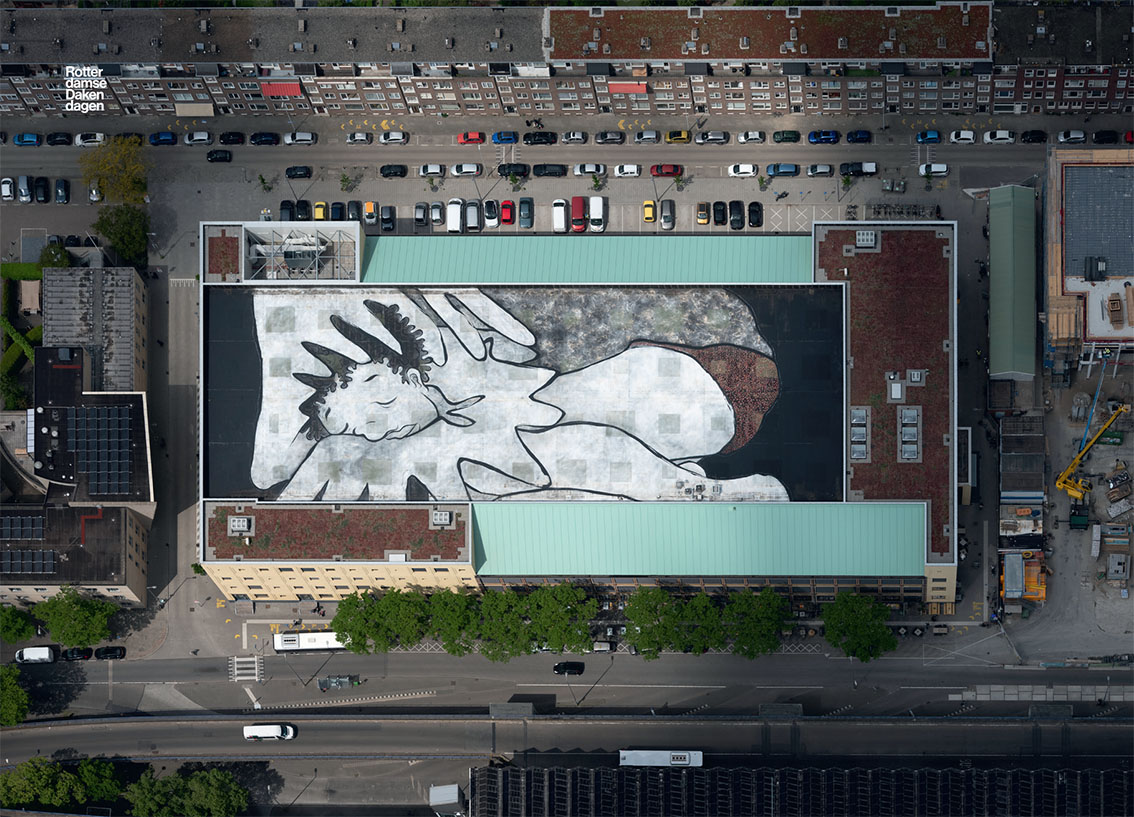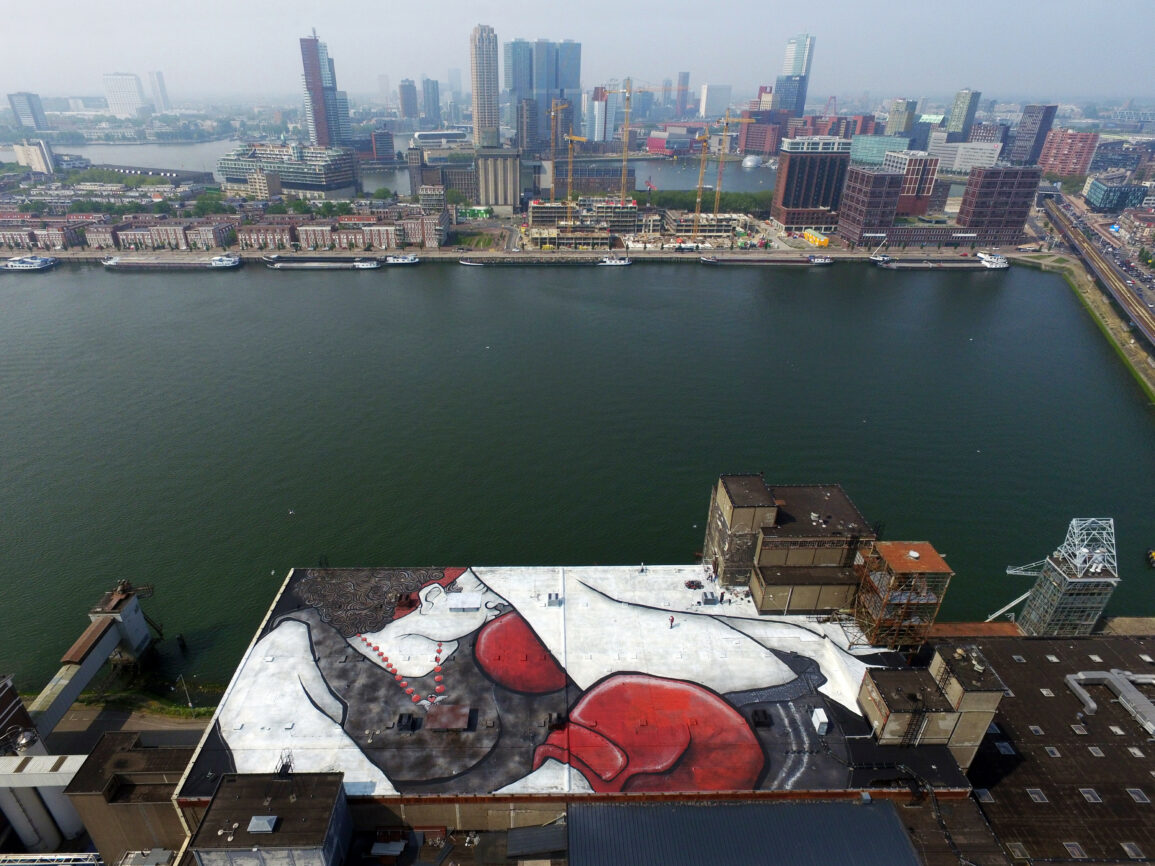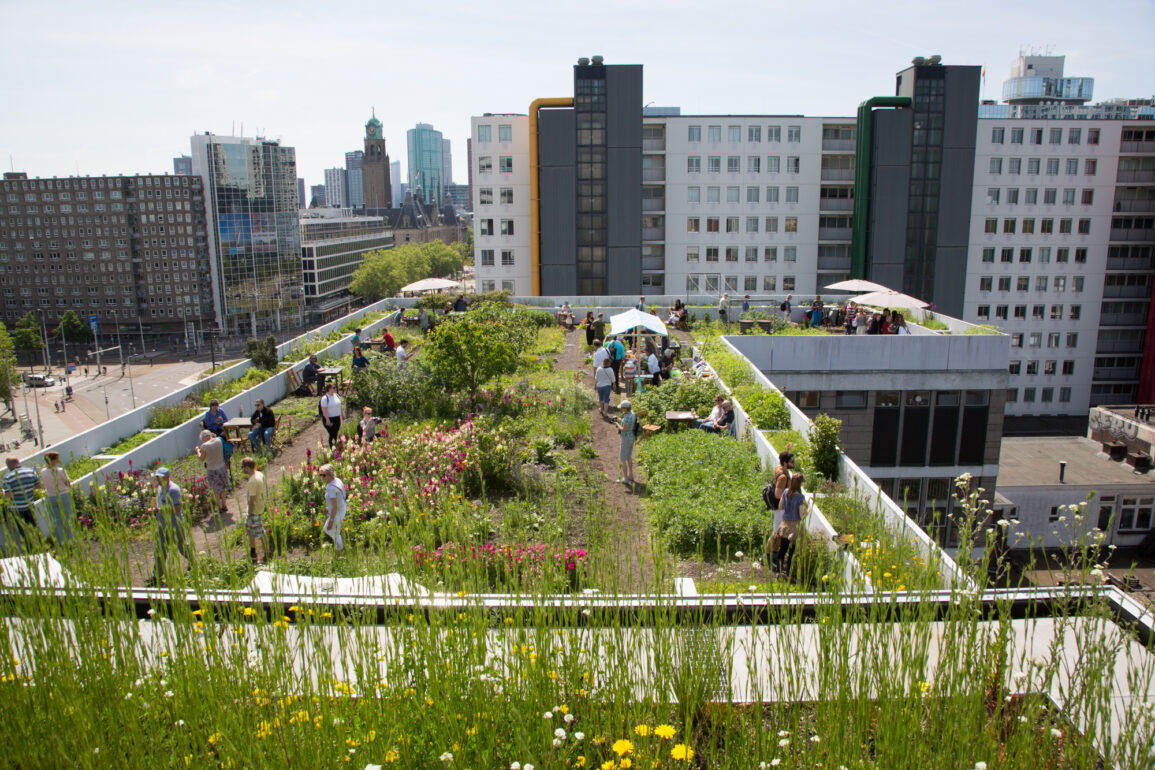
Author: Peter Frandsen

Rotterdam’s rooftops are diverse and exciting: from towering skyscrapers with stunning views to lush gardens above the city’s streets. All these places provide exciting views on and opportunities for the city as a whole.
Personally, rooftops provide me with a perspective on the world around me that is invaluable and inspiring. As an urban geographer, spatial patterns around me are revealed, I can make sense of connections between places in the city and the macro scale of urban life and processes becomes visible. This is also why I ended up choosing to examine them further for my master’s thesis in urban geography. For this, I contacted the Rotterdamse Dakendagen, because their especially innovative approach intrigued me and was something that I didn’t come across anywhere before. Thanks to them, I had the chance to visit many different roods during my research and talk to several ‘rooftop-makers’ in the Rotterdam. In this article I would like to give to you an insight into this research, some of its results and why Rotterdam’s rooftops are so interesting from an academic perspective.
It is no secret that the cities that we find ourselves in today face numerous challenges – both now and in the decades ahead. On a global scale, cities are more populous than ever and attract many new residents daily. In that sense, finding new ideas and solutions for cities to face the coming challenges, is crucial for a majority of earth’s population. Research in urban studies has looked into these issues for years now and identifies – amongst others – three important challenges.
The first and largest of these challenges is the sustainable adaptation to climate change and the building of resilience in order to deal with climate impacts. These endanger the well-being, as well as the physical structures of the city itself. This requires the grand effort of putting into action urban sustainability transitions that are already taking place and nearly all larger cities: reorganizing urban mobility, adapting to climate impacts, developing new policy instruments, etc.
The second is that of density and urban footprints. In many cities, green and public spaces are lacking and sprawling suburban growth fuels car dependency and even more consumerism. To solve these problems, we need to think creatively about the existing urban space and embrace density to decrease car-centric mobility and the ever-increasing consumption of green spaces around our cities.
The third challenge being discussed and that I want to mention here is that of changes in social bonds and networks. With the decline of religion and other traditional means of fostering strong local communities, new ways of fighting loneliness and building community have to be imagined and encouraged. This could take the shape of community gardens, creative spaces or similar places that enable social connections and co-creation.
Roofs are a good place to start for all three challenges, thanks to the immense amounts of space that we have at our disposal and that currently sit idle throughout most of our cities. Many great opportunities can be found here that can be exploited for everyone’s benefit and at a relatively low cost. I am sure, that all of you have anticipated this suggestion from the very start, but I hope to give you some fresh insights in the following paragraphs.
During my time in Rotterdam with the Rotterdamse Dakendagen, I was able to talk to several people in the city that are dealing with rooftops in one way or another. This gave me an insight into how the Rotterdamse Dakendagen operates and what consequences and impact their actions have in Rotterdam. I looked at this mostly from the lens of current urbanist research, namely aspects sustainability and temporary urban action.
It is important to mention beforehand that rooftops in Rotterdam are in a unique position: Numerous initiatives and programs have sprung up to do something with the ubiquitous, yet intriguing part of the city that are its rooftops, each in their own unique way. If you are reading this, I assume you are aware of some of the other initiatives besides the Rotterdamse Dakendagen, such as Rooftop Revolution, the Dakdorpen, the Dakenboek by Esther Wienese or one of the other initiatives. Due to this ecosystem of initiatives and actors, Rotterdam has become a pioneer in rooftop use, both in scale and diversity. In many other cities, rooftop use is almost exclusively encouraged by the municipality, which makes a broad push for rooftop conversion significantly more difficult.

So, how does the Dakendagen address the challenges that I mentioned in the beginning? It does so in a variety of ways, but I would like to focus on its innovative use of culture to add to the ‘classic’ sustainability ideas of environment, the social, and the economy.
By not only promoting a technocratic vision of a sustainable city, but instead promoting sustainable practices through fun and cultural events, the festival sets new standards of how a temporary event such as a festival can influence urban planning and policy beyond the event itself. Including art and culture in urban transformation processes such as reshaping the city’s rooftops helps to attract a broader audience and recognizes the importance of these elements in urban life. And indeed: Many researchers have pointed out before, that culture and art are not a luxury good, but essential to communities, individualist expression and democracy and should therefore also be included in sustainability targets.
Additionally, the festival also provides a platform for experts to share and discuss their knowledge with one another on the Knowledge Day. Sharing knowledge between experts and people active in a respective field is an essential and sometimes overlooked component of building a sustainable future. Especially relaxed and informal environments such as the festival often help to foster new ideas, creativity, and compromise, which is a kind of atmosphere that often lacks from official meetings.
Through these two examples presented above, as well as through the presentation of “normal” sustainable rooftop practices (e.g., pure green roofs), the Rotterdamse Dakendagen achieves the promotion of a strong vision of a possible, more sustainable urban future. Bringing culture into the mix is not only an innovative approach to sustainability, but in practice also helps to create multi-functional rooftops as opposed to the mono-functional, that are much more common (e.g., solar, green roofs). The municipality calls this multifunctionality a ‘golden’ rooftop and sees it as the ideal end goal of rooftop uses. This makes the festival an important advocate and maker of golden rooftops in Rotterdam. More generally it is unique in its recognition and active combination of all these usually separate ties of sustainability, which also makes it an intriguing example from an academic point of view. The Dakendagen do not only celebrate, but help to create ideas in people’s heads that tackle all the problems that we explored in the beginning.

The challenge now is to get the ideas from the Dakendagen out there, take them beyond Rotterdam with its productive ecosystem of rooftop innovators. What lessons and ideas can also be implemented elsewhere? How can municipalities encourage rooftop initiatives to form and how can independent initiatives create momentum in a city? With the founding of the European Creative Rooftops Network, a step has now been taken to address these questions and to export the creativity and energy that the festival brings to rooftops, yet each city requires its own answers. A next step from a research perspective could be to examine how the rooftop ecosystem in Rotterdam came into existence and which factors helped it to develop into the creative and innovative network that we see today.
For now, the message of the Dakendagen is clear: Only if we integrate arts, culture, fun, and community into the sustainable transformations of our cities can we truly succeed and inspire change from the bottom up. Everyone should be invited to imagine their city of tomorrow, and rooftops are just one place to start, yet definitely one of the most exciting.